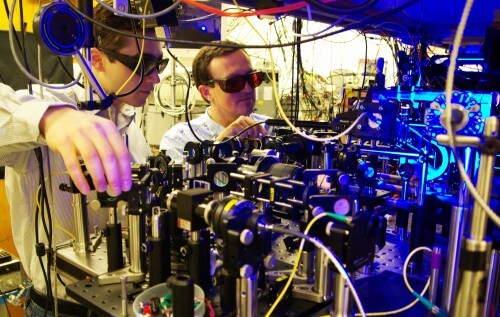Physicists have succeeded, with the help of a laser that excites a single atom from super-cooled rubidium gas, to develop an innovative method for producing separate photons quickly and efficiently, photons that can be used in processing quantum information for optics, as well as in other important research fields

Physicists succeeded, with the help of a laser that excites a single atom from super-cooled rubidium gas, to develop an innovative method for producing separate photons quickly and efficiently, photons that could be used in quantum information processing for optics, as well as in other important research fields.
The new technique takes advantage of the unique properties of the atom - it always contains one or more electrons that excite it to a level of almost full ionization (a state known as the "Rydberg state"). Atoms in this highly excited state have prominent electromagnetic properties and react strongly with each other. This fact allows the Rydberg atom (an atom containing an electron that is in this quantum state) to block the information originating from other excitable atoms located at a distance of 20-10 microns from it.
In the next step, this individual Rydberg atom can be converted into a photon, thus ensuring - on average - that a single photon is generated from a collection of rubidium atoms containing hundreds of tightly packed atoms. Producing a single photon with known properties is an important step for several fields of research, including systems of quantum information.
The findings of the study, which was supported by the US National Science Foundation (NSF) and the US Air Force Department of Scientific Research (AFOSR), were published in the online version of the prestigious scientific journal Science (Science Express).
"We are able to very efficiently convert Rydberg-type excited states into single photons, which allows us to reach the electronic state we are interested in at any moment we want," explains Alex Kuzmich, a professor in the School of Physics at the Georgia Institute of Technology. "The new system provides a rich platform for studying electronic states of atoms, spin and photons.
The team of scientists studied quantum information systems based on mapping information from atoms that are converted into entangled pairs of photons. However, the method they used to create the photons (Raman scattering) was not efficient enough and failed to provide the number of entangled photons required for complex systems. "This photon source is a thousand times faster than existing systems," explains the researcher.
In order to produce the Rydberg atom, the researchers used a laser beam that was projected onto a compressed collection of hundreds of rubidium atoms that had previously been cooled by a laser and confined into an optical lattice. The laser beam caused one atom from among the entire collection to go into the Rydberg state. Atoms excited to the Rydberg state react strongly with other Rydberg atoms and under suitable conditions, they can change the energies of the atomic levels and prevent the conversion of another atom to the Rydberg state - a phenomenon known as "Rydberg blocking". Rydberg atoms exhibit these strong interactions in the 20-10 micron range. By limiting the original collection of rubidium atoms to this range of distances, the researchers were able to ensure that no more than a single such atom would be created at a time. "The excited Rydberg atom "needs" space around itself and does not allow other Rydberg atoms to approach it," explains the researcher. "Our collection had a limited volume, so we were unable to fit more than one atom into the available volume."
Once a highly excited atom was created, the researchers used an additional laser field to convert it into light. Since the beam was created by Atom Rydberg, it includes a single photon, which can be used in a variety of fields, such as quantum logic gates used in quantum information systems.

3 תגובות
Thanks Ruby,
This is exactly the tool I need to examine the claim that a single photon, free from "social" constraints, will move along a random path that is not necessarily a straight line
To Yuval,
You were looking for such a process to create a single photon...
"In the next step, this separate Rydberg atom can be converted into a photon" - success in converting the atom into a photon,
I'm ready to buy some of these…